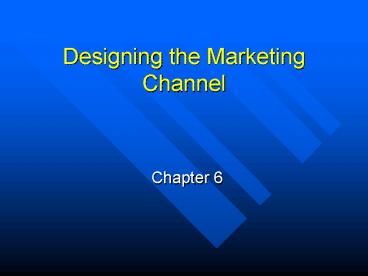Designing the Marketing Channel - PowerPoint PPT Presentation
1 / 19
Title:
Designing the Marketing Channel
Description:
Channel design refers to decisions associated with the formation of new ... a quick delivery usually long channels, think cut flower, fruits and veggies. ... – PowerPoint PPT presentation
Number of Views:445
Avg rating:3.0/5.0
Title: Designing the Marketing Channel
1
Designing the Marketing Channel
- Chapter 6
2
Channel Design
- Channel design refers to decisions associated
with the formation of new marketing channels of
the alteration of existing channels. - Differential Advantage Sustainable Competitive
Advantage (SCA). - SCAs offer long-term market advantages relative
to competitors.
3
(No Transcript)
4
Who Engages in Channel Design?
6
Objective 2
Firms
Wholesalers
Retailers
Look up the channel to secure suppliers
Producers, manufacturers, service providers,
franchisors Look down the channel toward the
market
Look both up and down the channel
5
Channel Design Paradigm
Objective 3
6
- Recognize the need for
- channel design decision
7. Select channel members
2. Set coordinate distribution objectives
6. Choose the best channel structure
3. Specify distribution tasks
5. Evaluate relevant variables
4. Develop alternative channel structures
6
When to Make a ChannelDesign Decision
6
Objective 4
- Dealing with changes in availability of
particular kinds of intermediaries - Opening up new geographic marketing areas
- Facing the occurrence of major environmental
changes - Meeting the challenge of conflict or other
behavioral problems - Reviewing and evaluating
- Developing a new product or product line
- Aiming an existing product at a new market
- Making a major change in some other component of
the marketing mix - Establishing a new firm
- Adapting to changing intermediary policies that
may inhibit attainment of distribution objectives
7
Channel Structure Dimensions
6
Objective 7
1. Number of levels in the channel
2. Intensity at the various levels
Allocation Alternatives
3. Types of intermediaries at each level
8
Distribution Intensity
- Number of Intermediaries
- Intensive Distribution.
- Location Demand, Low Involvement
- Gum, Coke, Gasoline
- Exclusive Distribution.
- Producer maintains control of the quality and
consistency of service. Often required to not
carry competing demands - Prestige-Rolex
- Selective Distribution.
- Between Intensive and exclusive
- Carefully selected
- Car sales
9
Intensity at the Various Levels
6
Relationship between the intensity of
distribution dimension number of retail
intermediaries used in a given market area
Intensity Dimension
Intensive Selective Exclusive
Numbers of Intermediaries (retail level)
Many Few One
10
Other Variables Affecting Channel Structure
- Market variables
- Market geography, market size and density, market
behavior - Product variables
- Bulk and weight, Perishability, unit value
(e-commerce implications too) - Company variables
- Intermediary variables
- Environmental Variables
- Behavioral variables
- Relationships with other channel members
11
Product Variables
- Bulk and Weight the bigger and heavier things
are, the more you are going to want to ship in
big bundles direct to the user. - Perishability Obviously want a quick delivery
usually long channels, think cut flower, fruits
and veggies. - Unit Value The lower the value, the longer the
channel (because of low margins for distribution,
very large economies of scales are necessary
12
Selecting the Best Channel Design
- The best channel design is one that offers the
highest performance effectiveness, and the lowest
possible cost. - Next well discuss means and techniques for
choosing the best channel structure
13
Characteristics of Goods Parallel Systems Approach
- Five Factors or Dimensions of Products
- Replacement Rate
- Gross Margin (on products)
- Adjustments (service requirements to meet
consumer needs) - Time of consumption (how long do you use it)
- Search Time (How long does it take to get to the
store/distance) - Book pages 207, 208
14
Color Classification Scheme
From Textbook, p. 207-208
Aspinwalls scheme from Lazer and Kelly (1962)
15
Relationship Between Product Characteristics and
Channel Length
Red Orange Yellow
Products
Channels
Long Medium Short
From Textbook
16
Financial Approach
- Look at channel as an investment
- Which channel has the highest return
- HIGHEST NPV
- Calculate estimated returns on the investment
- Problemwhat financial indicators do you use?
17
Transactional Cost Analysis Approach
- Transaction Specific Assets, both tangible (e.g.,
special machinery) and intangible (e.g.,
training) - Opportunism
- Vertical integration
- Problem ignores relationship marketing and
focuses only on a narrow aspect of channel design
18
Management Science Approaches
- Mathematical models that estimate the outcomes
for various channel designs - Example
- ln (SALESi) d g ln (SPEOPi) - mi
- for every district i
- mi gt 0 for every district i.
- Problem Can only use in limited applications to
date, limited by the ability of the designer of
the model
19
Judgment-Heuristic Approach
- Qualitative (Seat of the Pants)
- Weighted factor

